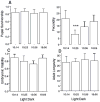Concordance of the circadian clock with the environment is necessary to maximize fitness in natural populations
- PMID: 18194469
- PMCID: PMC4288752
- DOI: 10.1111/j.1558-5646.2008.00324.x
Concordance of the circadian clock with the environment is necessary to maximize fitness in natural populations
Abstract
The ubiquity of endogenous, circadian (daily) clocks among eukaryotes has long been held as evidence that they serve an adaptive function, usually cited as the ability to properly time biological events in concordance with the daily cycling of the environment. Herein we test directly whether fitness is a function of the matching of the period of an organism's circadian clock with that of its environment. We find that fitness, measured as the per capita expectation of future offspring, a composite measure of fitness incorporating both survivorship and reproduction, is maximized in environments that are integral multiples of the period of the organism's circadian clock. Hence, we show that organisms require temporal concordance between their internal circadian clocks and their external environment to maximize fitness and thus the long-held assumption is true that, having evolved in a 24-h world, circadian clocks are adaptive.
Figures


Similar articles
-
The adaptive value of circadian clocks: an experimental assessment in cyanobacteria.Curr Biol. 2004 Aug 24;14(16):1481-6. doi: 10.1016/j.cub.2004.08.023. Curr Biol. 2004. PMID: 15324665
-
Adaptive significance of circadian clocks.Chronobiol Int. 2003 Nov;20(6):901-19. doi: 10.1081/cbi-120026099. Chronobiol Int. 2003. PMID: 14680135 Review.
-
Chromatin, photoperiod and the Arabidopsis circadian clock: a question of time.Semin Cell Dev Biol. 2008 Dec;19(6):554-9. doi: 10.1016/j.semcdb.2008.07.012. Epub 2008 Jul 30. Semin Cell Dev Biol. 2008. PMID: 18708153 Review.
-
What season is it anyway? Circadian tracking vs. photoperiodic anticipation in insects.J Biol Rhythms. 2010 Jun;25(3):155-65. doi: 10.1177/0748730410365656. J Biol Rhythms. 2010. PMID: 20484687 Review.
-
Circadian clocks in daily and seasonal control of development.Science. 2003 Jul 18;301(5631):326-8. doi: 10.1126/science.1085935. Science. 2003. PMID: 12869749 Review.
Cited by
-
Clocks for the city: circadian differences between forest and city songbirds.Proc Biol Sci. 2013 Jun 5;280(1763):20130593. doi: 10.1098/rspb.2013.0593. Print 2013 Jul 22. Proc Biol Sci. 2013. PMID: 23740778 Free PMC article.
-
CLOCK and BMAL1 regulate MyoD and are necessary for maintenance of skeletal muscle phenotype and function.Proc Natl Acad Sci U S A. 2010 Nov 2;107(44):19090-5. doi: 10.1073/pnas.1014523107. Epub 2010 Oct 18. Proc Natl Acad Sci U S A. 2010. PMID: 20956306 Free PMC article.
-
Jumonji domain protein JMJD5 functions in both the plant and human circadian systems.Proc Natl Acad Sci U S A. 2010 Dec 14;107(50):21623-8. doi: 10.1073/pnas.1014204108. Epub 2010 Nov 29. Proc Natl Acad Sci U S A. 2010. PMID: 21115819 Free PMC article.
-
Identification of the Molecular Clockwork of the Oyster Crassostrea gigas.PLoS One. 2017 Jan 10;12(1):e0169790. doi: 10.1371/journal.pone.0169790. eCollection 2017. PLoS One. 2017. PMID: 28072861 Free PMC article.
-
Proximate mechanisms driving circadian control of neuroendocrine function: Lessons from the young and old.Integr Comp Biol. 2009 Nov;49(5):519-37. doi: 10.1093/icb/icp041. Epub 2009 Jun 14. Integr Comp Biol. 2009. PMID: 21665838 Free PMC article.
References
-
- Aschoff J. Survival value of diurnal rhythms. In: Edholm O, editor. Biology of survival; Symposium of the Zoological Society of London; London. 1964. pp. 79–98.
-
- Beaver LM, Rush BL, Gvakharia BO, Giebultowicz JM. Noncircadian regulation and function of clock genes period and timeless in oogenesis of Drosophila melanogaster. J Biol Rhythms. 2003;18:463–472. - PubMed
-
- Bell G. Measuring the cost of reproduction. 1. The correlation structure of the life table of a plankton rotifer. Evolution. 1984;38:300–313. - PubMed
-
- Bradshaw WE, Lounibos LP. Evolution of dormancy and its photoperiodic control in pitcher-plant mosquitoes. Evolution. 1977;31:546–567. - PubMed
Publication types
MeSH terms
Grants and funding
LinkOut - more resources
Full Text Sources
Medical
